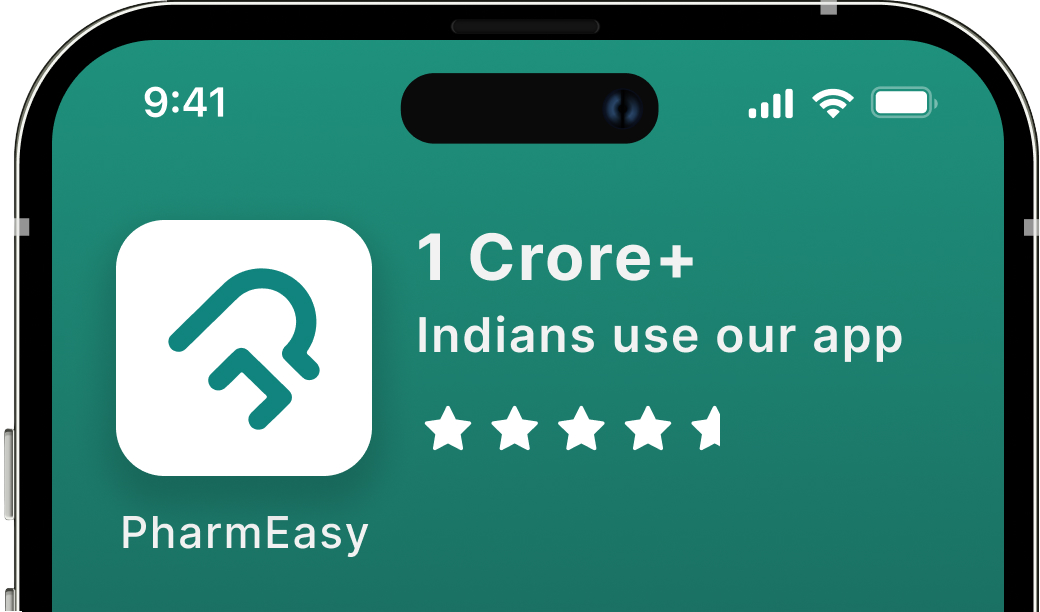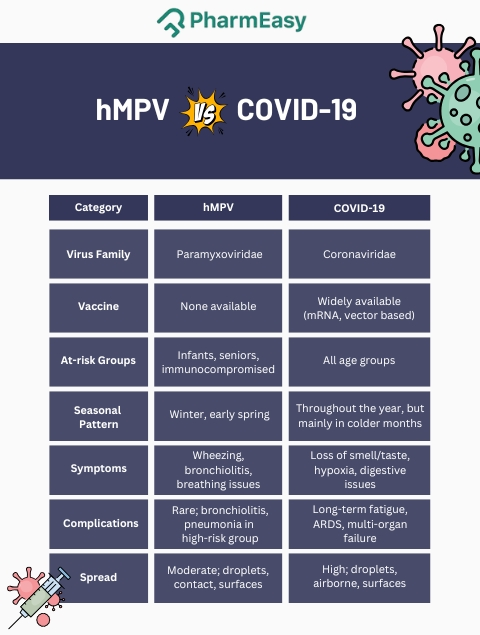hMPV: Understanding the Virus, Its Spread, and How to Stay Safe
By Dr. Arpit Verma +2 more

Get,

to manage your symptom
Get your,


4 Cr+ families
benefitted

OTP sent to 9988776655



You’ve successfully subscribed to receive
doctor-approved tips on
Whatsapp

Get ready to feel your best.

Hi There,
Download the PharmEasy App now!!


Register to Avail the Offer
Send OTPBy continuing, you agree with our Privacy Policy and Terms and Conditions

Hi There,
Sign up on PharmEasy now!!
Trusted by 4 crore+ families

OTP sent to 9988776655



You have unlocked 25% off on medicines




Code: NU25
By Dr. Arpit Verma +2 more
Table of Contents
The recent hMPV outbreak in China has brought Human Metapneumovirus (hMPV) into the spotlight. While the virus is not new to the medical community, its sudden surge in media reports has sparked comparisons to COVID-19 and raised concerns about its possible impact.
| hMPV Cases in IndiaAs of January 7, 2025, India has reported 7 confirmed cases of Human Metapneumovirus (hMPV) infections. These cases have been detected in Bengaluru, Nagpur, Tamil Nadu, and Ahmedabad. Disclaimer: The number of cases is subject to change as new data becomes available. Please refer to official health sources for the most current information. |
hMPV is a respiratory virus that belongs to the Paramyxoviridae family. It is known to cause illnesses ranging from mild cold-like symptoms to more severe respiratory conditions, especially in young children and older people. The virus is transmitted through respiratory droplets and typically circulates in winter and early spring.

Despite its recent emergence in public awareness, hMPV was first identified in 2001 by Dutch researchers who isolated the virus from children suffering from acute respiratory illnesses. Subsequent studies revealed that hMPV had been circulating in human populations for decades prior to its discovery, often misdiagnosed as other respiratory infections due to similarities in symptoms.
hMPV infection can present with a variety of symptoms, ranging from mild to severe.
While most cases of hMPV are mild, severe complications can occur:
hMPV spreads in ways similar to other respiratory infections such as COVID and the flu, and understanding its transmission can help you reduce the risk of getting infected.
The estimated Incubation Period Of hMPV infection is 3-6 days.
hMPV infection is more common in the colder months, typically peaking during winter and early spring:
hMPV doesn’t affect everyone equally, and understanding the groups that are at higher risk helps in prioritizing preventive care.
hMPV symptoms often resemble those of other respiratory infections, like influenza, RSV, and the common cold. As a result, doctors rely on both clinical evaluation and laboratory tests to accurately diagnose the condition.
While there is currently no targeted antiviral therapy or vaccine available for hMPV, treatment focuses on managing symptoms and supporting recovery:
Preventive measures can significantly reduce the risk of hMPV transmission and infection. Thankfully, we’re already familiar with these precautionary measures because they’re very similar to the ones we practised during the COVID pandemic.
People at risk should maintain physical distancing from individuals showing symptoms of respiratory infections and avoid sharing personal items like utensils or towels. Wear a mask while taking care of someone who is showing symptoms of hMPV or flu-like illness.
As of January 2025, there is no approved vaccine for hMPV. However, recent research efforts are actively exploring vaccine development:
Make sure infants and adults receive all the recommended vaccines as a preventive measure.
Role of Other Vaccines – It is important to stay updated with all your vaccinations for influenza and covid-19 to reduce the risk of serious illness due to co-infections.
In light of the recent surge in hMPV cases, it’s natural to draw comparisons with the COVID-19 pandemic experienced a few years ago. Understanding the distinctions between these two viruses is essential for informed awareness and appropriate response.

Even though hMPV is common, it’s not as well-known as other respiratory viruses. It often gets overlooked because its symptoms are similar to those of the flu and the like. Most people recover with some home care, but in severe cases, complications can arise if not addressed early.
That’s why more research and awareness are needed to fully understand and manage hMPV. The good news is that vaccine trials are showing promise for better prevention and treatment options.
If you experience symptoms or complications, don’t panic—avoid self-medicating and consult your doctor. It’s always better to seek help early, ideally within a couple of days. Simple steps like wearing a mask, maintaining personal hygiene, and avoiding crowds can make all the difference. Stay healthy and stay safe!
No, hMPV is not new. It has been circulating in humans globally and was first identified by researchers in 2001.
Since symptoms overlap with those of other respiratory viruses like RSV, flu, and COVID-19, specific lab testing is necessary to confirm hMPV.
The illness typically lasts 5–10 days. Mild cases often resolve within a week, but in at-risk groups, it may last longer and occasionally require medical attention.
No, hMPV is not a pandemic threat as per the recent reports. It is a well-studied virus with predictable seasonal patterns and widespread immunity among the global population.
hMPV can survive on surfaces for several hours. Disinfecting commonly touched objects like doorknobs, phones, and countertops is essential to prevent its spread.
Disclaimer: The information provided here is for educational/awareness purposes only and is not intended to be a substitute for medical treatment by a healthcare professional and should not be relied upon to diagnose or treat any medical condition. The reader should consult a registered medical practitioner to determine the appropriateness of the information and before consuming any medication. PharmEasy does not provide any guarantee or warranty (express or implied) regarding the accuracy, adequacy, completeness, legality, reliability or usefulness of the information; and disclaims any liability arising thereof.
Links and product recommendations in the information provided here are advertisements of third-party products available on the website. PharmEasy does not make any representation on the accuracy or suitability of such products/services. Advertisements do not influence the editorial decisions or content. The information in this blog is subject to change without notice. The authors and administrators reserve the right to modify, add, or remove content without notification. It is your responsibility to review this disclaimer regularly for any changes.

Leave your comment...
Comments